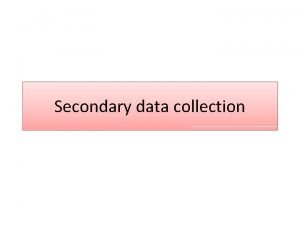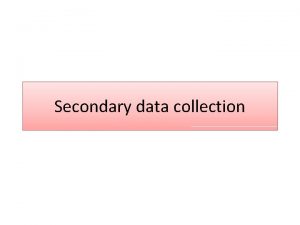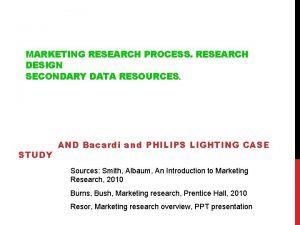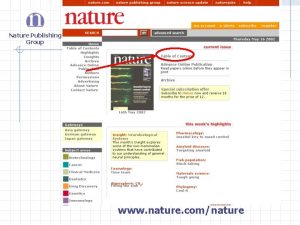4 Secondary Data Nature of Secondary Data Secondary










- Slides: 10

4. Secondary Data

Nature of Secondary Data • Secondary data: data that have been previously gathered. • Primary data: new data gathered to help solve the problem under investigation.

Advantages and Limitations of Secondary Data • Advantages: faster and less expensive than acquiring primary data • Limitations: – Lack of availability – Lack of relevance – Inaccuracy – Insufficiency

Objectives for Secondary Data Research Designs Broad Objective Specific Research Example Fact-finding: seek to uncover all available info. about some market related topics. -Identifying consumption patterns -Tracking trends Model building: the use of secondary -Estimating market potential data to help specify relationships between -Forecasting sales 2 or more variables. -Selecting trade areas and sites Database marketing: the use of customer databases to promote one-to-one relationships with customers and create precisely targeted promotions. -Enhancing customer databases -Developing prospect lists

Data Mining • The use of powerful computers to dig through volumes of data to discover patterns about an org. ’s customers and products. – Market basket analysis analyses anonymous point of sale transaction databases to identify coinciding purchases/ relationships between products purchased and other retail shopping info. – Example: Osco Drugs in the US mined its databases provided by checkout scanners and found that when men go to its stores to by baby’s nappies in the evening between 6 -8 pm. , they sometimes walk out with a six-pack of beer as well. Knowing this behavioral pattern, it’s possible for store managers in supermarket chains to lay out their stores so that these items are closer together.

Data Mining • Example: the credit card company probably track info. about each customer: age, gender, number of children, job status, income level, past credit card history, and etc. The data about these factors will be mined to find the patterns that make a particular individual a good or bad credit risk known as customer discovery.

Data Mining • When a company knows the identify of the customer who makes repeated purchases from the same org. , an analysis can be made of sequences of purchases. Sequence discovery, the use of data mining to detect sequence patterns, is popular among direct marketers, such as catalogue retailer. A catalogue merchant has info. for each customer such as the set of products customer buy in every purchase order.

Sources of Secondary Data • Internal and proprietary data sources: secondary data that originate inside the organization • External data: data created, recorded, or generated by an entity other than the researcher’s org. • Information as a product and its distribution channels: libraries, the Internet, vendors, producers, books and periodicals, government sources, media sources, trade association sources, commercial sources

Single-Source Data-Integrated Information • Diverse types of data offered by a single company. The data are usually integrated on the basis of a common variable such as geographic area or store. – Example: MRI Cable Report – Mediamark www. mediamark. com Integrates info. on cable research including TV viewing with demographic and product usage info.

Sources for Global Research • As business has become more global, so has the secondary data industry. • International researchers should watch for certain pitfalls that can be associated with foreign data and cross-cultural research such as the unavailability of data in certain countries, the accuracy of some data may be called into question, different definitions in economic terminology in various countries.
 Nature and nature's law lay hid in night
Nature and nature's law lay hid in night Nature nature controversy
Nature nature controversy Syndicated secondary data
Syndicated secondary data The terms external secondary data and syndicated
The terms external secondary data and syndicated Content analysis is a type of secondary data analysis
Content analysis is a type of secondary data analysis Primary data and secondary data
Primary data and secondary data Primary data and secondary data
Primary data and secondary data What is a primary data
What is a primary data Secondary data examples
Secondary data examples Primary data and secondary data
Primary data and secondary data What is primary data
What is primary data


















